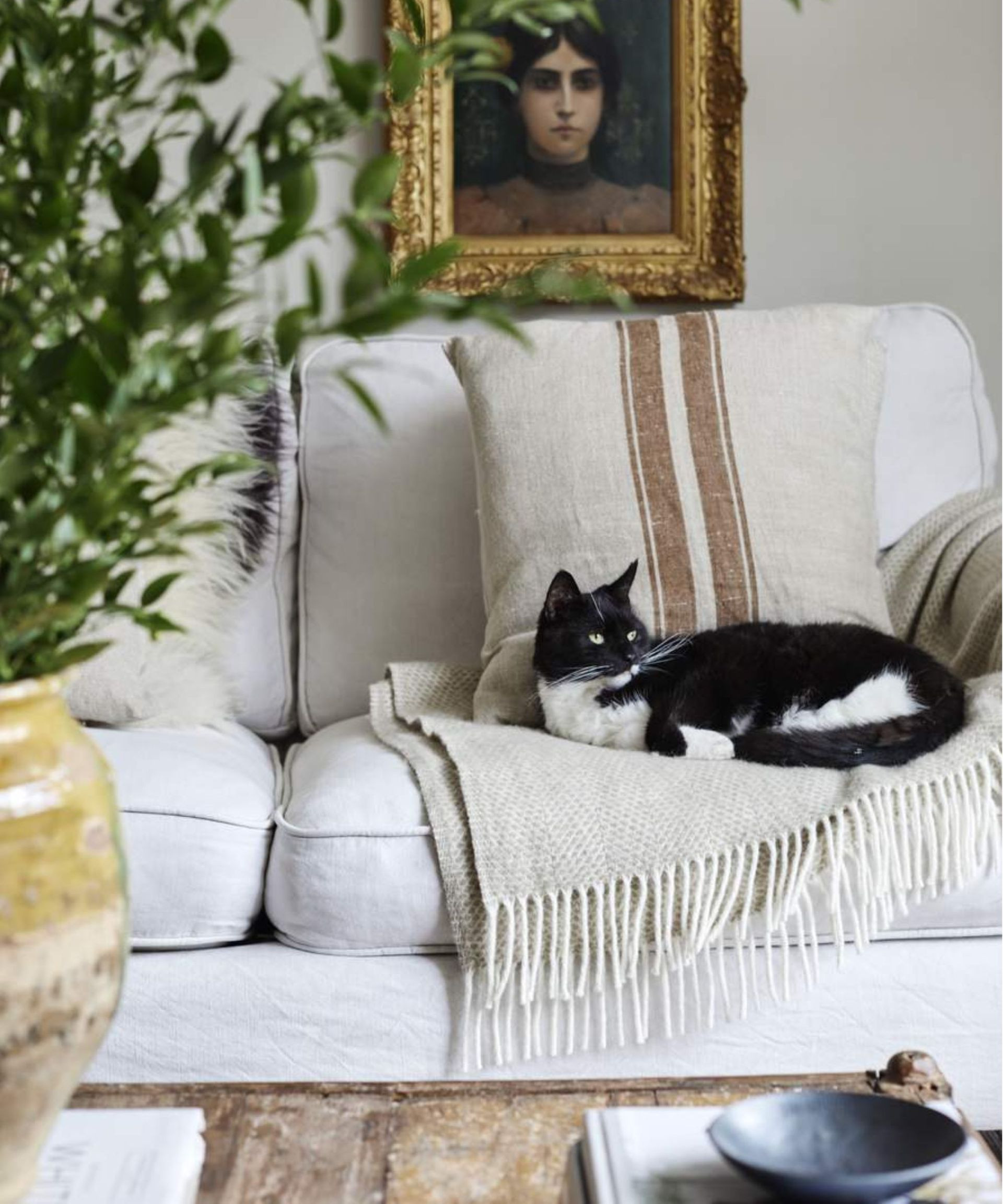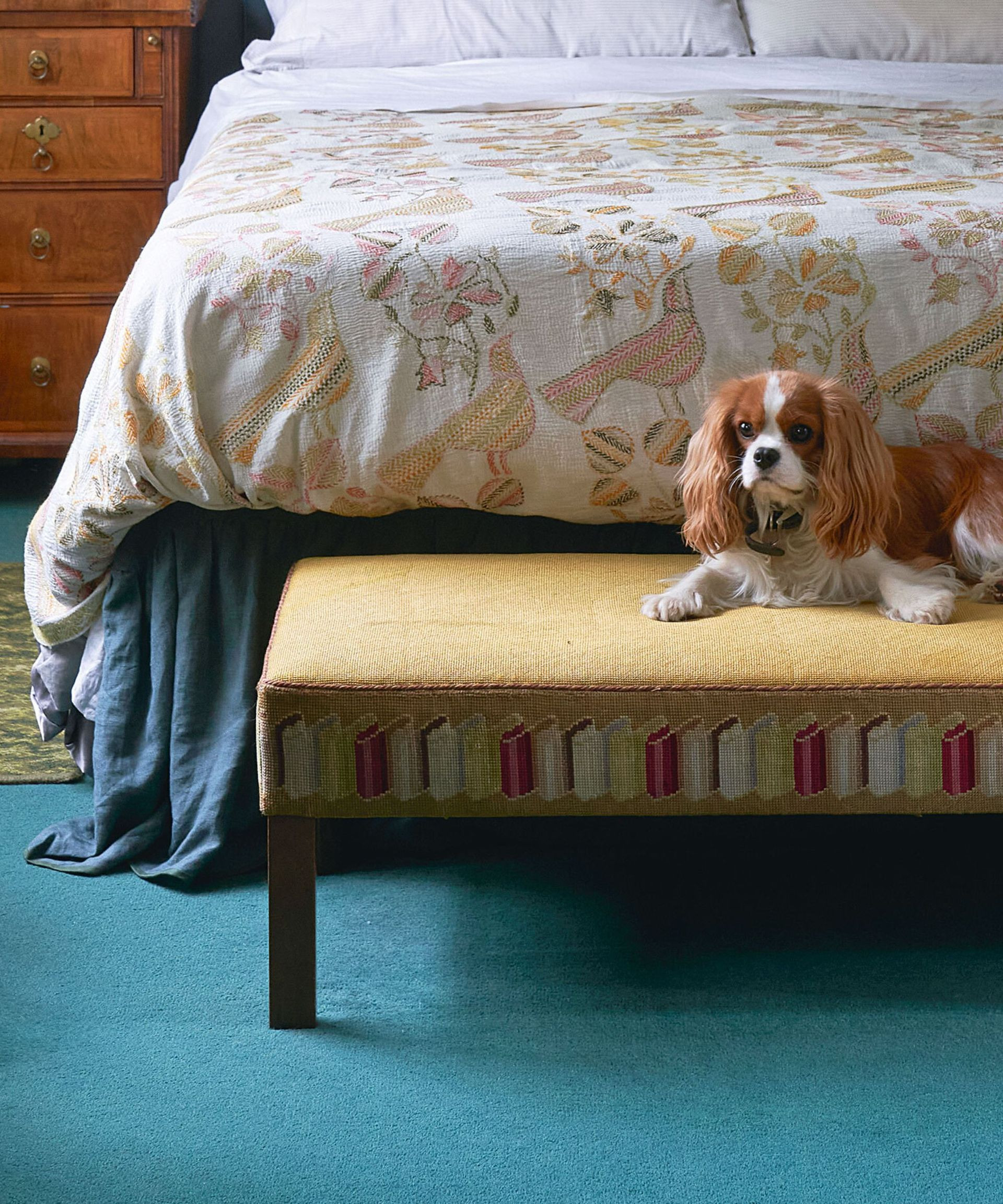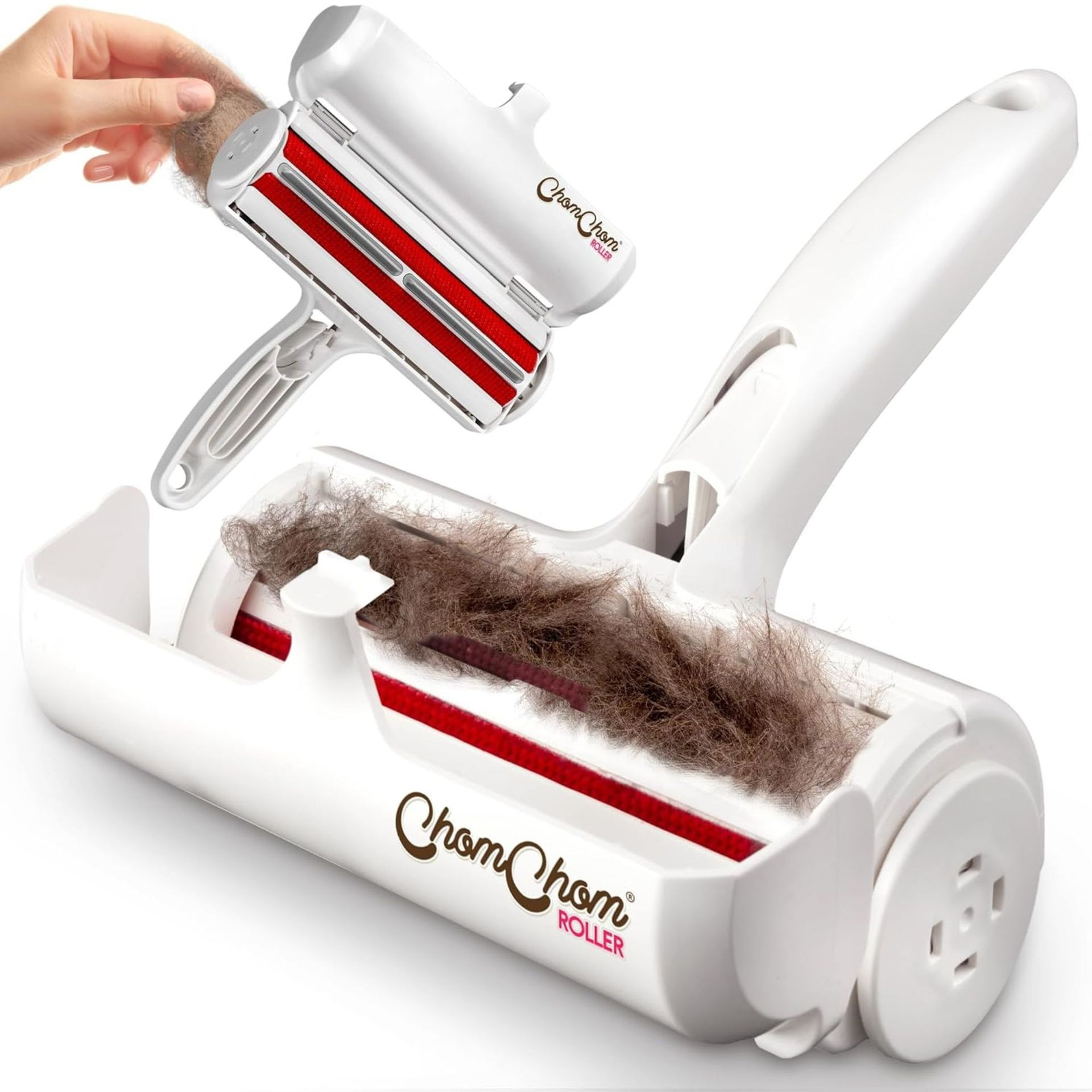Are you a cat lover constantly battling the never-ending shedding? Getting cat hair off clothing, furniture, and other fabrics can feel like an uphill battle. But don’t worry, solcat.net is here to help. We’ll explore proven methods and expert tips to eliminate cat hair and maintain a hair-free home. Learn how to tackle this common challenge with ease, using solutions like lint rollers, anti-static sprays, and proper laundry techniques.
1. What is the Best Way to Remove Cat Hair from Clothing Using a Lint Roller?
A lint roller is one of the simplest and most effective tools for removing cat hair from clothing. It’s an excellent way to quickly grab loose fur from fabrics. The sticky surface of the roller lifts cat hair efficiently, making it a go-to solution for many pet owners.
Lint rollers are incredibly effective on fabric sofas, chairs, and cushions. The perforated sheets make tearing off the used ones easy, ensuring a fresh, sticky surface is always ready. For dealing with stubborn cat hair, consider using a lint brush with soft bristles. These brushes gently remove pet hair without damaging the fabric. Repeat the process until you’ve successfully eliminated all visible hair.
 A brown and white spaniel on a green dog bed in a modern grey living room with bright colorful artwork, white painted shabby chic bench with assorted cushions, round wooden stool next to a countertop and large windows with view of garden behind, with beige and white striped blinds
A brown and white spaniel on a green dog bed in a modern grey living room with bright colorful artwork, white painted shabby chic bench with assorted cushions, round wooden stool next to a countertop and large windows with view of garden behind, with beige and white striped blinds
Alt text: A well-designed living room featuring a dog bed with a spaniel, showcasing a space that needs regular cat hair removal from furniture.
If you’re out of lint rollers, sticky tape can work in a pinch. Simply wrap the tape around your hand with the sticky side facing out, and dab it over the fabric to pick up the hair. If you’re looking for a sustainable option, consider a reusable lint roller. These rollers can be washed and reused, reducing waste and providing a reliable solution for removing cat hair from your clothing and home furnishings.
2. How Effective is Vacuuming at Removing Cat Hair from Clothing and Fabrics?
Vacuuming is an efficient method for removing cat hair from fabrics, especially upholstery and carpets. Using a vacuum with the right attachments can lift embedded cat hair from sofas and chairs. However, vacuuming may not be suitable for all types of clothing.
For the best results, use a vacuum cleaner with pet-specific attachments. These tools are designed to agitate and lift cat hair from fabric surfaces effectively. A handheld vacuum can be particularly useful for quick cleanups and reaching difficult areas.
 Dog on grey vinyl floor in front of dark grey walls, wooden stairs, bench with cushion and throw, and large flowers in vase in modern home entryway
Dog on grey vinyl floor in front of dark grey walls, wooden stairs, bench with cushion and throw, and large flowers in vase in modern home entryway
Alt text: A modern home entryway with a dog on a grey floor, illustrating a common area where vacuuming can help manage pet hair.
While vacuuming is excellent for removing the bulk of hair from couches and carpets, it might not catch every strand. For bedding and clothing, a handheld option or lint roller may work more effectively. Regular vacuuming, combined with other methods, can significantly reduce the amount of cat hair in your home.
3. Can a Pet Brush Really Help Remove Cat Hair from Clothing?
Yes, a pet brush can be surprisingly effective at removing cat hair from clothing and other fabrics. Pet brushes, especially those with soft bristles, can gently lift hair without damaging delicate materials. This method is particularly useful for items that can’t be easily vacuumed or lint-rolled.
Using a cat’s brush to tackle hair on blankets and clothing can yield great results. Pull the material taut and brush the fabric as you would the cat. The effectiveness may vary depending on the type of brush and the breed of cat. An undercoat rake, for example, is more effective on pilled fabrics like carpets, while a soft brush is ideal for cleaning upholstery and clothes without causing damage.
 A tuxedo cat sat on a throw on a cream couch with a gold framed painting on the wall above
A tuxedo cat sat on a throw on a cream couch with a gold framed painting on the wall above
Alt text: A tuxedo cat sitting on a cream couch, highlighting how pet brushes can help maintain furniture by removing loose hair.
To maximize the benefits, regularly brush your cat to reduce shedding. This proactive approach minimizes the amount of hair that ends up on your clothing and furniture in the first place. Combine this with using a pet brush on your clothes, and you’ll notice a significant reduction in cat hair buildup.
4. How Does Anti-Static Spray Help in Removing Cat Hair from Clothing?
Anti-static sprays are a versatile solution for preventing and removing cat hair from clothing, laundry, and fabrics. These sprays prevent small particles and fibers from sticking to fabrics, making it easier to remove cat hair.
To create your own anti-static spray, combine two tablespoons of fabric softener with one cup of water and a tablespoon of rubbing alcohol in a spray bottle. Shake well to combine. Liberally apply the spray to any areas with hair. While the spray helps loosen the hair, you’ll need to combine it with another removal method, such as vacuuming or using a lint roller, to collect the hair.
 A dog sitting in a boot room hallway
A dog sitting in a boot room hallway
Alt text: A dog in a boot room hallway, suggesting the use of anti-static spray to prevent hair from sticking to surfaces.
Anti-static sprays are particularly effective for preventing hair from sticking to clothing. A quick spritz before following up with a lint roller or brush can make a significant difference. Be cautious when making homemade sprays; use a small amount of fabric conditioner as it increases flammability and could stain.
Additionally, using white vinegar in your laundry can help reduce static cling. Add ½ cup of distilled white vinegar to a large load of laundry to relax the clothing fibers and reduce the laundry’s pH. This reduces static cling, preventing cat hair from sticking to your garments.
5. Is It Possible to Use Rubber Gloves to Remove Cat Hair from Clothing?
Yes, rubber gloves are a surprisingly effective tool for removing cat hair from clothing and fabrics. Slightly dampen a rubber glove and rub it over the fabric. The static and friction will lift pet hair into clumps for easy removal.
Any textured dishwashing glove will work, but gloves with a good grip and durability are ideal. After using the gloves, simply vacuum up any clumped fur and dander.
 A black cat sat on a bed in front of a wood panelled wall with pegs, with a rattan bag, two hats and a bright vintage style poster hanging up and a large houseplant in a wicker basket at the end of the bed
A black cat sat on a bed in front of a wood panelled wall with pegs, with a rattan bag, two hats and a bright vintage style poster hanging up and a large houseplant in a wicker basket at the end of the bed
Alt text: A black cat on a bed, showcasing the use of rubber gloves for removing hair from bedding and other fabrics.
This method is particularly useful for larger surfaces like sofas and bedding. The rubber gloves create enough friction to gather the hair, making it easy to collect and dispose of. It’s a simple, low-cost solution for managing cat hair in your home.
6. How Can I Prevent Cat Hair from Sticking to My Clothes in the First Place?
Preventing cat hair from sticking to your clothes is key to minimizing the need for constant removal. Regular grooming, proper laundry techniques, and using fabric protectors can significantly reduce the amount of cat hair that ends up on your clothing.
Regularly brush your cat to remove loose hair before it has a chance to settle on your clothes and furniture. This is one of the most effective preemptive measures you can take. According to the American Animal Hospital Association (AAHA), regular grooming not only reduces shedding but also helps maintain your cat’s coat health.
Consider using fabric protectors on your furniture to create a barrier that prevents cat hair from embedding in the fibers. These protectors can be sprayed onto upholstery and carpets to make it easier to remove hair with a vacuum or lint roller.
7. What Laundry Techniques Can Help Remove Cat Hair from Clothing?
Proper laundry techniques can make a significant difference in removing cat hair from clothing. Adding certain products to your wash cycle and cleaning your machines regularly can help prevent hair from clinging to your clothes.
Adding just ½ cup of distilled white vinegar to a large load of laundry can help relax the clothing fibers and reduce static cling. This allows the hair to be washed away more easily. Use dryer sheets or wool dryer balls to further reduce static. Wool dryer balls, moistened slightly with water, are particularly effective.
 A Cavalier King Charles Spaniel on a yellow patterned ottoman at the end of a bed with patterned bedding on a bright blue carpet with a brown wooden chest of drawers with brass detailing in the background
A Cavalier King Charles Spaniel on a yellow patterned ottoman at the end of a bed with patterned bedding on a bright blue carpet with a brown wooden chest of drawers with brass detailing in the background
Alt text: A bedroom scene with a dog on an ottoman, demonstrating how vinegar and dryer balls can reduce pet hair on fabrics.
Regularly clean your washing machine and tumble dryer to remove accumulated cat hair. According to Stuart Pyburn, franchise consultant and appliance expert at Mr. Appliance, hair can stick around inside the drum for several washes, adding hair to clothes that may have previously been relatively hair-free.
8. Can Certain Fabrics Attract More Cat Hair Than Others?
Yes, certain fabrics tend to attract more cat hair than others. Fabrics with a lot of texture or static cling, such as fleece, velvet, and corduroy, are notorious for attracting and holding onto pet hair.
Smooth, tightly woven fabrics like cotton, linen, and silk tend to attract less hair. Consider choosing these fabrics for your clothing and upholstery to minimize the amount of cat hair you have to deal with.
Using fabric softeners and anti-static sprays can also help reduce the amount of static cling in your fabrics, preventing cat hair from sticking.
9. What Are Some Common Mistakes People Make When Trying to Remove Cat Hair from Clothing?
Several common mistakes can hinder your efforts to remove cat hair from clothing. Not pre-treating clothes, using the wrong tools, and neglecting machine maintenance are just a few.
One common mistake is not removing as much pet hair as possible before washing your clothing. Washing clothes covered in pet hair can cause the hair to clump up and clog your washing machine’s pipes and filters.
Another mistake is using the wrong tools or techniques for the fabric you’re trying to clean. Using a rough brush on delicate fabrics, for example, can cause damage. Always use the appropriate tools and techniques for the specific fabric.
10. Are There Any Professional Services That Can Help Remove Cat Hair from Clothing and Fabrics?
Yes, several professional services can help remove cat hair from clothing and fabrics. Professional cleaners, upholstery cleaners, and specialized pet hair removal services are all options to consider.
Professional cleaners have specialized equipment and techniques for removing pet hair from clothing and other fabrics. They can effectively remove embedded hair and leave your clothes looking fresh and clean.
Upholstery cleaners can deep clean your furniture and remove pet hair, dander, and allergens. They use specialized equipment and cleaning solutions to restore your furniture to its original condition. Some companies, like Bear Brothers Cleaning, have been featured on Martha Stewart for their cleaning expertise.
By addressing these questions and incorporating the suggested techniques, you can effectively manage cat hair on your clothing and in your home, ensuring a cleaner and more comfortable living environment.
11. What Innovative Products Are Available for Cat Hair Removal from Clothing?
The market offers several innovative products designed to make cat hair removal from clothing easier and more efficient. These range from specialized lint rollers to advanced vacuum attachments and even laundry additives.
One popular option is the Chom Chom Roller Pet Hair Remover. This reusable lint roller is designed specifically for pet hair and features a handy compartment for collecting loose hair for easy disposal. Its effectiveness and eco-friendly design make it a favorite among pet owners.
 A white pet hair remover filled with brown pet hair with a hand holding it in the background
A white pet hair remover filled with brown pet hair with a hand holding it in the background
Alt text: A Chom Chom Roller filled with pet hair, demonstrating its effectiveness in removing cat hair from clothing and fabrics.
Another innovative product is the Bissell Pet Hair Eraser Lithium Ion Cordless Hand Vacuum. This handheld vacuum is designed to remove embedded dirt and pet hair from various surfaces. Its motorized brush tool and cordless design make it ideal for quick cleanups and hard-to-reach areas.
12. How Can I Incorporate Cat Hair Removal into My Daily Routine?
Making cat hair removal a part of your daily routine can prevent buildup and make the task less daunting. Simple habits like a quick lint roll and regular vacuuming can keep your home and clothing looking clean.
Start by keeping a lint roller in a convenient location, such as your entryway or bedroom. Use it to quickly remove any visible cat hair from your clothing before leaving the house. Regular brushing of your cat is also crucial to minimizing shedding.
Schedule regular vacuuming sessions to remove cat hair from your floors, carpets, and upholstery. A quick vacuum every few days can prevent hair from becoming deeply embedded in the fibers.
13. What Natural or DIY Solutions Can I Use to Remove Cat Hair from Clothing?
For those who prefer natural or DIY solutions, several options can effectively remove cat hair from clothing without harsh chemicals. These include using vinegar, baking soda, and homemade anti-static sprays.
Vinegar is a natural fabric softener and can help reduce static cling, making it easier to remove cat hair. Add ½ cup of distilled white vinegar to your laundry to help relax the clothing fibers and prevent hair from sticking.
Baking soda can be used as a pre-wash treatment to loosen cat hair from clothing. Sprinkle baking soda on your clothes and let it sit for a few minutes before washing. This can help loosen the hair and make it easier to remove in the wash cycle.
14. How Do I Choose the Right Tools and Products for Cat Hair Removal?
Choosing the right tools and products for cat hair removal depends on several factors, including the type of fabric, the amount of hair, and your personal preferences. Consider the following when selecting your cat hair removal tools:
For delicate fabrics, opt for soft-bristled brushes or reusable lint rollers. These tools are gentle on fabrics and won’t cause damage. For upholstery and carpets, choose a vacuum cleaner with pet-specific attachments or a carpet rake.
Consider the amount of hair you need to remove. If you have a heavy-shedding cat, you may need more powerful tools like a high-suction vacuum or a specialized pet hair remover.
15. What Are Some Expert Tips for Keeping My Home Cat Hair-Free?
Keeping your home cat hair-free requires a combination of proactive measures and consistent cleaning. Here are some expert tips to help you manage cat hair in your home:
According to the Cornell Feline Health Center, regular grooming is essential for managing shedding. Aim to brush your cat at least once a week, or more frequently during shedding season.
Create designated pet-free zones in your home, such as bedrooms or living areas. This can help contain the amount of cat hair and reduce the overall cleaning burden.
By incorporating these tips and techniques, you can effectively manage cat hair on your clothing and in your home, creating a cleaner and more comfortable environment for both you and your feline friend. For more information and resources on cat care, visit solcat.net.
16. How Often Should I Wash My Clothes to Remove Cat Hair?
The frequency of washing your clothes to remove cat hair depends on how much your cat sheds and how much contact you have with your feline friend. As a general guideline, washing clothes that frequently come into contact with your cat at least once a week is a good starting point.
If you notice a significant amount of cat hair on your clothes, consider washing them more frequently. This is particularly important during shedding season when cats tend to lose more hair than usual.
Also, remember to clean your washing machine regularly. Pet hair can accumulate inside the drum and other parts of the machine, which can then transfer onto your clean clothes during subsequent washes.
17. Are There Specific Washing Machine Settings That Help Remove Cat Hair?
Yes, there are specific washing machine settings that can help remove cat hair from your clothes more effectively. Using the right settings can make a significant difference in the amount of hair that is removed during the wash cycle.
Consider using a pre-wash or extra rinse cycle to help loosen and remove cat hair before the main wash cycle. These cycles can help dislodge hair that is deeply embedded in the fabric.
Also, select a high water level and a gentle wash cycle. The high water level helps to float the hair away from the clothes, while the gentle cycle prevents the hair from becoming further embedded in the fabric.
18. How Can I Protect My Furniture from Cat Hair?
Protecting your furniture from cat hair is essential for maintaining a clean and hair-free home. There are several strategies you can use to minimize the amount of cat hair that ends up on your furniture and make it easier to clean.
Consider using furniture covers or throws. These can protect your furniture from cat hair, scratches, and other damage. Choose machine-washable covers for easy cleaning.
Also, regularly vacuum your furniture to remove cat hair before it becomes deeply embedded in the fibers. Use a vacuum cleaner with pet-specific attachments for best results.
 A black cat sat on a bed in front of a wood panelled wall with pegs, with a rattan bag, two hats and a bright vintage style poster hanging up and a large houseplant in a wicker basket at the end of the bed
A black cat sat on a bed in front of a wood panelled wall with pegs, with a rattan bag, two hats and a bright vintage style poster hanging up and a large houseplant in a wicker basket at the end of the bed
Alt text: A black cat on a bed, showcasing the use of rubber gloves for removing hair from bedding and other fabrics.
Additionally, provide your cat with designated scratching posts and beds. This can help redirect their attention away from your furniture and reduce the amount of hair that ends up on your sofas and chairs.
19. What Types of Cat Breeds Shed the Most Hair?
The amount of hair a cat sheds can vary depending on the breed. Some cat breeds are known for shedding more than others. Understanding which breeds shed the most can help you prepare for the challenge of managing cat hair in your home.
Long-haired breeds, such as Persians, Maine Coons, and Ragdolls, tend to shed the most hair. Their long coats require regular grooming to prevent matting and reduce shedding.
Also, short-haired breeds like American Shorthairs and British Shorthairs can also shed a significant amount of hair, particularly during shedding season.
If you are considering getting a cat, research the shedding potential of different breeds to make an informed decision based on your lifestyle and tolerance for cat hair.
20. How Does Diet Affect Cat Shedding and Hair Quality?
A cat’s diet can significantly impact their shedding and hair quality. Providing your cat with a balanced and nutritious diet can help minimize shedding and promote a healthy, shiny coat.
Ensure your cat’s diet is rich in essential fatty acids, such as omega-3 and omega-6. These fatty acids can help reduce inflammation and promote healthy skin and hair.
Also, provide your cat with plenty of fresh water to stay hydrated. Dehydration can lead to dry skin and increased shedding.
According to veterinary experts, high-quality cat food that is specifically formulated for hairball control can also help reduce shedding and improve hair quality.
By implementing these expert tips and strategies, you can effectively manage cat hair on your clothing and in your home, creating a cleaner, more comfortable, and enjoyable living environment for both you and your feline companion. Be sure to visit solcat.net for more valuable information and resources on cat care and maintenance.
At solcat.net, we understand the joys and challenges of cat ownership. We’re committed to providing you with reliable, up-to-date information and resources to help you care for your feline friend. Whether you’re dealing with cat hair on your clothing, behavioral issues, or health concerns, we’re here to support you every step of the way.
For more tips, tricks, and expert advice on cat care, be sure to explore our extensive collection of articles, images, and videos at solcat.net. Join our community of cat lovers and discover a wealth of information to help you provide the best possible life for your furry companion.
If you have any questions or need further assistance, don’t hesitate to contact us at +1 (206) 386-4000 or visit our website at solcat.net. Our team of experts is always ready to help you navigate the wonderful world of cats.
FAQs
1. What’s the quickest way to de-fuzz my clothes from cat fur?
The quickest way to de-fuzz your clothes from cat fur is to use a lint roller. Simply roll it over the affected areas to lift the hair.
2. How can I remove stubborn cat hair from my favorite sweater?
To remove stubborn cat hair from your favorite sweater, try using a pet brush with soft bristles. Gently brush the fabric to loosen and lift the hair.
3. Can I use dryer sheets to get rid of cat hair on clothing?
Yes, you can use dryer sheets to get rid of cat hair on clothing. Add a dryer sheet to your tumble dryer along with your clothes to reduce static and help remove hair.
4. What are some eco-friendly ways to remove cat hair from clothes?
Some eco-friendly ways to remove cat hair from clothes include using a reusable lint roller, a pet brush with natural bristles, or making your own anti-static spray with natural ingredients.
5. Is there a special vacuum cleaner for pet hair removal from fabrics?
Yes, there are vacuum cleaners with pet-specific attachments designed to remove pet hair from fabrics effectively. Look for models with motorized brush tools and strong suction.
6. How does white vinegar help in removing cat hair from laundry?
White vinegar helps in removing cat hair from laundry by reducing static cling. Add ½ cup of distilled white vinegar to your laundry to help relax the clothing fibers and prevent hair from sticking.
7. Can rubber gloves really pick up cat hair from clothing and furniture?
Yes, rubber gloves can pick up cat hair from clothing and furniture. Slightly dampen a rubber glove and rub it over the fabric to lift the hair into clumps for easy removal.
8. Are there any fabrics that don’t attract cat hair?
Fabrics with smooth, tightly woven textures, such as cotton, linen, and silk, tend to attract less cat hair compared to textured fabrics like fleece and velvet.
9. How can I prevent my washing machine from getting clogged with cat hair?
To prevent your washing machine from getting clogged with cat hair, remove as much hair as possible from your clothes before washing and regularly clean your machine by running an empty cycle with white vinegar.
10. Are professional pet hair removal services worth the cost?
Professional pet hair removal services can be worth the cost if you have a severe cat hair problem or if you lack the time or tools to effectively remove the hair yourself. These services have specialized equipment and techniques to deep clean your home and remove embedded pet hair.

